We’re off to Scandinavia in this edition of The Bread & Soup Project. This is our first venture into those northern climes, and the northernmost country we’ve approached so far (well, Canada goes further north, but also further south), and is the southernmost of the Scandinavian countries, also being the only one of those physically attached to Western Europe. We tend to think of it in terms of its penninsula, Jutland, but it also includes an archipelago of 443 named islands. Once a unified kingdom with Sweden and Norway, back to the 8th century, it has had its series of battles between neighbors over territory on up until the early 1800s when it became fully a separate kingdom. Though still a kingdom, the monarchy is no longer the sole governing power, since going democratic in 1849.
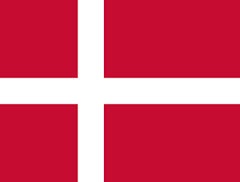 At just shy of 17,000 square miles, Denmark proper falls in size midway between Maryland and West Virginia, though a good portion of that is territorial water surrounding the archipelago. It shares a single physical border with Germany, a stretch of only 42 miles in length. The population is just shy of 6 million, most of whom live on either Jutland or the largest islands, Zeeland and Funen, the former of which is where the capital, Copenhagen, is located. All of that, however, is dwarfed by the fact that Greenland is, while autonomous, a Danish territory, encompassing a land and ice mass almost as big as Alaska and Texas combined, making Denmark officially the 12th largest country in the world.
At just shy of 17,000 square miles, Denmark proper falls in size midway between Maryland and West Virginia, though a good portion of that is territorial water surrounding the archipelago. It shares a single physical border with Germany, a stretch of only 42 miles in length. The population is just shy of 6 million, most of whom live on either Jutland or the largest islands, Zeeland and Funen, the former of which is where the capital, Copenhagen, is located. All of that, however, is dwarfed by the fact that Greenland is, while autonomous, a Danish territory, encompassing a land and ice mass almost as big as Alaska and Texas combined, making Denmark officially the 12th largest country in the world.
Prior to the EU, Denmark was fairly homogeneously Danish. These days it’s about 86% Danish, with the balance being a mix of immigrants from across the rest of the EU, as well a more recent influx of primarily Middle Eastern refugees. About 3/4 of the population identify as the local version of Lutheran, the Church of Denmark, and the constitution of the country mandates that the king or queen be a member of the church. Until 1970, the country only officially recognized three other religions, Roman Catholic, Reformed Church, and Judaism, though since then, by royal decree, “religious societies” are considered accepted. With the influx of refugees, around 5% of the population is now Muslim, the largest religious minority group.
Meat and fish are heavily represented in Danish cuisine, and since industrialization, ground meats, particularly pork, are extremely popular. And, of course, there are the open faced rye or other whole grain bread sandwiches, smørrebrød, that many of us are familiar with. Selecting candidates for this project was surprisingly difficult. The soup wasn’t all that hard – pea soups, and “clear soup” (klar suppe) seem to dominate the canon. I ended up settling on Hønsekødssuppe, which literally just means chicken soup, but appears to regularly involve both dumplings and pork meatballs. For the bread, I wasn’t going to go the pastry route of a savory danish, and I didn’t want to just make another loaf of rye or whole grain brain, albeit that they seem to be ubiquitous. I ended up deciding on something that’s not really traditional, but a modern interpretation of a seeded oat bread that just sounded like something different and interesting to make. For the purists, we’ll treat the dumplings as the bread element.
Let’s go for the soup first this time. I’m not going to show making chicken stock, suffice it to say I put a bunch of chicken wings, an onion, a leek, some thyme, parsley, bay leaf, salt, and black peppercorns into a pot with about two liters of water, brought it to a simmer and cooked it for about 45 minutes, then strained it (I ate the chicken wings, tossed with hot sauce, for lunch). Into this, I put a large diced carrot and thinly sliced stalk of celery, brought it back to a simmer and cooked for 10 minutes to soften the vegetables.
For our dumplings we have about a cup of flour, 3 ounces of melted butter, a tablespoon of milk, an egg, a 1/4 teaspoon of salt and about 1/8 teaspoon each of black pepper and cardamom.
Mix the dry ingredients together, then add the milk and the egg yolk. Whisk the egg white until it’s stiff, and then fold it into the dumpling mixture.
Bring a pot of salted water to a boil (get that started while you make this and the meatball mixture), and form balls of the dumpling mixture (I used a large melon baller), and drop them into the boiling water. When they float, scoop them out and right into the soup pot with the stock and vegetables.
We have about half a pound of ground pork, an egg, 2 tablespoons of breadcrumbs, some chopped parsley, a 1/2 teaspoon of salt and a 1/4 teaspoon of black pepper.
Mix them all together well. And then repeat the process as with the dumplings, make meatballs, again, I just used the same melon baller, it was quick and easy, right into the same pot that you just used for cooking the dumplings, and again, the meatballs will float when they’re cooked through. Scoop the floating ones right out and plop them into the soup pot.
Add a little chopped parsley, and the soup is done!
Simple and basic, but absolutely delicious. And surprisingly light dumplings.
This is a seed heavy bread. We’ve got about a cup of oats, a half cup of sunflower seeds, a third cup of flax seeds, a quarter cup each of psyllium husk powder (binding agent) and the same of almonds, a couple of tablespoons of chia seeds, three of butter, one of maple syrup or honey, a teaspoon of salt, and a cup and a half of water.
Mix all the dry ingredients together well.
Heat the water, butter, and maple syrup/honey up together to melt the butter. Easiest thing was just put the latter two into the water and stick it in the microwave for a minute. Then mix into the dry ingredients until well incorporated.
Fill a loaf pan and press the mixture down well. Leave to sit for at least two hours so that everything hydrates well. The mixture will firm up significantly.
First, bake in a hot oven for 20 minutes, and then remove from the mold, flipping it over onto a rack, and put it back in the oven for another 30 minutes until…
…it’s a beautiful golden brown, and sounds hollow when you thump it.
And, serve up a bowl of the soup along with a couple of slices of this bread, buttered if you like. Yum! The bread is really tasty, albeit a bit of a workout to chew with all those seeds. It’s really nice toasted. And let’s say it will keep you regular. Loved the soup. It’s so basic, but so tasty, no wonder it’s a classic.
Next time, we’re once again back to Africa, and Djibouti.
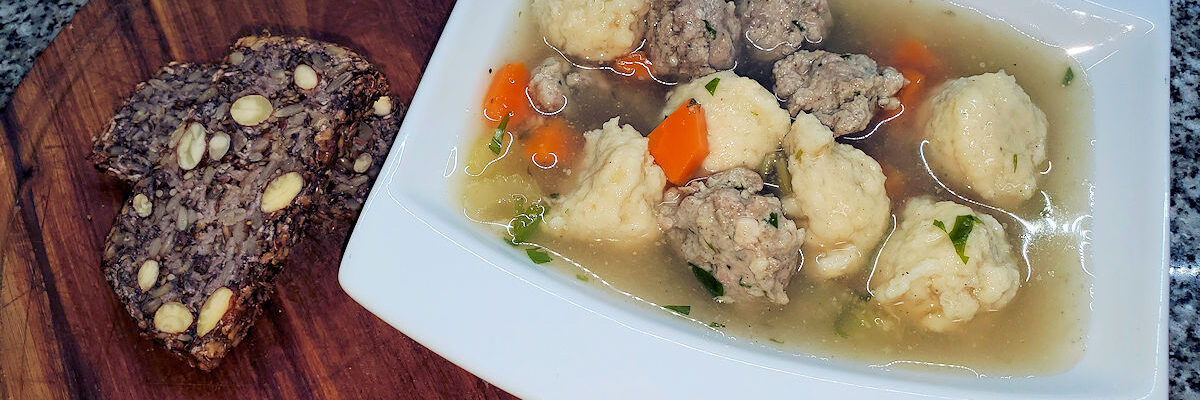
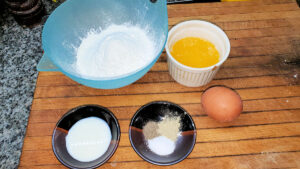
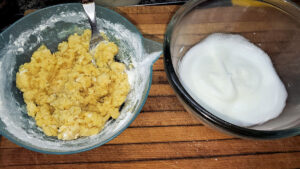
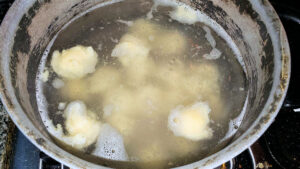
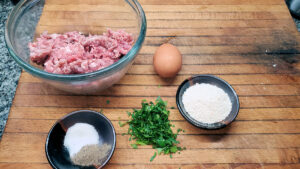
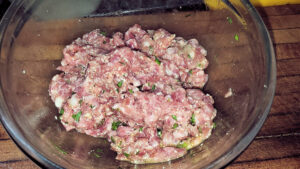
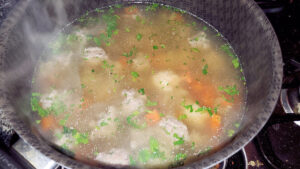
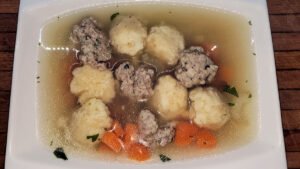
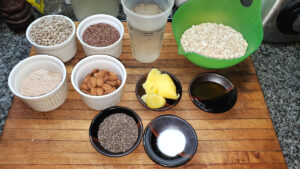
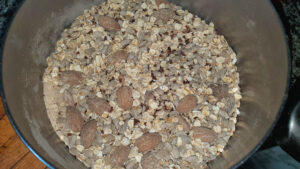
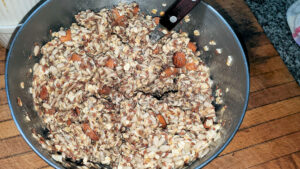
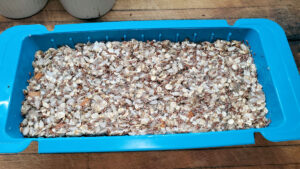
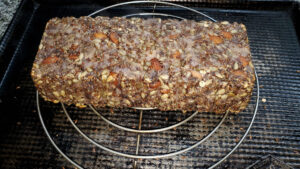
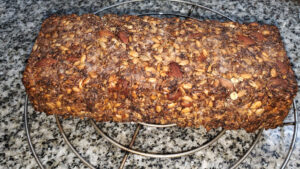
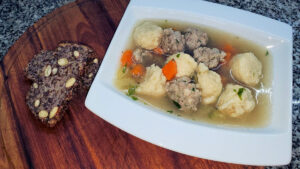
[…] Next time, it’s off to Denmark. […]